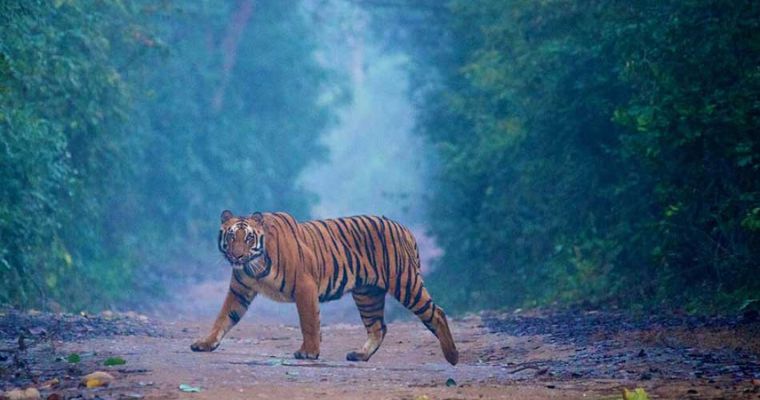contact us. is by the Kosi River. It offers a peaceful stay in Jim Corbett National Park. This park is famous in India for its wildlife.
The park is full of wildlife and beauty. It's perfect for those who love nature and adventure. But, picking the best time for a wildlife safari experience can be hard.
Finding the right season is key. It helps you see a tiger in its home. Knowing the best season to visit makes your trip unforgettable.
Jim Corbett National Park: An Overview
Jim Corbett National Park is one of the oldest in India. It offers a unique wildlife experience. It was started in 1936 and is key to saving nature.
History and Ecological Significance
Jim Corbett National Park has a long history. It's not just about when it was made. It's also about its role in keeping nature alive.
The park is vital for keeping the area's biodiversity. It's home to many plants and animals. Its different areas, like grasslands and forests, support a lot of life.
Wildlife Diversity and Tiger Population
The park is famous for its wide range of wildlife. It has a lot of tigers. This makes it a great place to see tigers.
Key Species to Spot During Your Visit
When you visit Jim Corbett, you can see many animals. Here are some:
- Tigers
- Elephants
- Deer species
- Numerous bird species
Understanding the Best Time to Visit in Jim Corbett
To get the most out of your wildlife safari in Jim Corbett, knowing the park's climate is key. The park's varied geography and location lead to different climates all year.
Year-Round Climate Patterns
Jim Corbett has a subtropical climate. It has hot summers and cold winters. The monsoon season brings lots of rain.
The park has three main seasons: summer, monsoon, and winter. October is a time between the monsoon and winter.
Park Opening Schedule by Season
The park opens at different times each season. Jim Corbett National Park is open from mid-November to mid-June. Some areas open and close at different times.
- Winter season: November to February (peak tourist season)
- Summer season: March to June (wildlife congregates around water sources)
- Monsoon season: July to September (park remains closed due to heavy rainfall)
Peak vs. Off-Peak Visitor Seasons
Knowing when it's busy or quiet can help plan your trip. The peak season, from November to February, has nice weather and more wildlife.
The off-peak season, like summer, is hot. But, you might see more wildlife near water.
Winter Season: Prime Time for Tiger Sightings
Jim Corbett's winter, from November to February, is great for tiger sightings. The weather is cool and nice, perfect for visiting and going on safari.
November to February Wildlife Activity
In winter, Jim Corbett's wildlife is more active. They visit water and open areas more often. This is because it's cooler and they're more active during the day.
The forests are less dense because of leaf shedding. This makes it easier to see animals. You'll also see many migratory birds, making your visit even better.
Optimal Safari Timing During Winter Days
For the best chance to see wildlife, go on safaris early morning or late afternoon. These times have the best light and animals are more active.
- Early morning safaris are peaceful with the sunrise.
- Late afternoon safaris are great for seeing predators hunt.
- The weather is calm, making the ride through the forest comfortable.
Winter Photography Opportunities
Winter in Jim Corbett is perfect for photography. The skies are clear, and the sunlight is soft. This makes for beautiful photos of wildlife and landscapes.
December-January: The Golden Period for Safaris
December and January are the best times to visit Jim Corbett. Seeing tigers is much easier because of the weather and animal activity.
- The cool weather helps animals be active during the day.
- The less dense vegetation makes it easier to see animals.
- The nice weather makes the whole experience better.
Summer Safari Experience in Jim Corbett
The summer in Jim Corbett is special for seeing animals. They gather near water because it's hot. This makes summer great for those who love safaris.
March to June Wildlife Concentration
From March to June, it gets really hot. Water is hard to find. So, animals go to the few water spots they can find.
This makes it easy to see many animals. It's a good time for safari fans.
Water Hole Sightings and Predator Activity
Water holes are where animals go in summer. Predators like tigers and leopards wait there for food. It's exciting to see this.
Visitors get to see the wild in action. It's a thrilling experience.
Heat Management Tips for Summer Safaris
It's important to stay cool in summer safaris. Here's how:
- Drink lots of water.
- Wear clothes that let air through.
- Stay out of the sun when it's hottest.
Early Morning and Evening Safari Advantages
Going on safaris early in the morning or late in the evening is best. It's cooler and you can see more animals.
Early morning safaris are peaceful. You see animals when they're most active. Evening safaris are exciting. Animals move more as the sun goes down.
Monsoon Period: Limited Access and Considerations
The monsoon season changes Jim Corbett National Park a lot. It makes the park's ecosystem fresh. But, there are rules to keep visitors safe and protect animals.
July to October Park Restrictions
From July to October, many parts of Jim Corbett National Park are shut. This is because of lots of rain and flooding. It's to keep everyone safe and the park's buildings sound.
Key restrictions include:
- Closure of safari zones due to safety concerns
- Limited access to certain areas of the park
- Restrictions on visitor activities
Which Zones Remain Open During Rainy Season
Even though many zones are closed, some might stay open. Always check with park officials for the latest on which zones are open.
Post-Monsoon Wildlife Viewing Benefits
The monsoon season has its limits, but after it, you can see more wildlife. The park looks fresh and animals come out more. It's a great time to see animals.
Benefits of post-monsoon visits include:
- Enhanced wildlife viewing due to concentrated water sources
- Lush vegetation providing a natural backdrop for photography
- Cooler temperatures making safaris more comfortable
Safari Zones in Jim Corbett: Seasonal Specialties
Exploring Jim Corbett's safari zones is key to seeing its rich wildlife. Each zone has its own wildlife and habitats. This makes the visit diverse and fun.
Dhikala Zone: Best Months and Booking Requirements
The Dhikala zone is very popular in Jim Corbett. It's known for lots of wildlife. The best time to visit Dhikala is from November to February. This is when you can see tigers and other animals better.
Booking for Dhikala can be hard because it's so popular. So, book your safaris early, even in peak season.
Bijrani and Jhirna: Year-Round Access Options
Bijrani and Jhirna zones are open all year. They give visitors flexibility. Bijrani is famous for tiger sightings. Jhirna is open all year, even in the monsoon. It shows wildlife in a lush green setting.
Durga Devi and Sitabani: Lesser-Known Treasures
Durga Devi and Sitabani are not as well-known. They offer a quiet experience. Durga Devi is known for its tough terrain and diverse wildlife. Sitabani lets you see the forest's plants and animals.
Zone-Specific Wildlife Sighting Probabilities
- Dhikala: High chance of seeing tigers and deer
- Bijrani: Good for tiger and leopard sightings
- Jhirna: You might see deer and sometimes tigers
- Durga Devi: Good for spotting bears and birds
- Sitabani: Known for its birdlife and sometimes leopards
Knowing what each zone offers can make your Jim Corbett visit better. It lets you plan your trip based on what wildlife you want to see.
Tarangi Resort: Enhancing Your Jim Corbett Experience
Tarangi Resort is by the calm Kosi River. It's in the heart of Jim Corbett National Park's wild. You get to see beautiful views of the river.
Staying at Tarangi Resort is great after a wildlife safari. It's peaceful and lets you relax. The resort has comfy rooms and beautiful views.
Guests can use the resort's facilities and enjoy the views. Tarangi Resort is perfect for a great Jim Corbett visit. You can go on safaris and relax in nature.
FAQ
What is the best season to visit Jim Corbett for a tiger safari?
The best time to see tigers in Jim Corbett is from November to February. This is the winter season.
Is December a good time for a Jim Corbett trip?
Yes, December is a great time to visit Jim Corbett. It's winter, perfect for seeing tigers and taking photos.
Can we visit Jim Corbett during the monsoon season?
Visiting Jim Corbett in the monsoon (July to October) is tricky. Some areas are closed due to rain. But, Jhirna is open all year.
What are the best months to visit the Dhikala zone in Jim Corbett?
The best months for Dhikala zone are November to June. November to February is busy. March to June is better for wildlife near water.
Are Bijrani and Jhirna zones accessible year-round?
Yes, Bijrani and Jhirna are open all year. They're good for those who want fewer people or are visiting off-season.
What is the optimal timing for a safari in Jim Corbett during winter?
The best times for winter safaris are early morning and late afternoon. The weather is cool, and animals are active.
How does the summer season affect wildlife viewing in Jim Corbett?
Summer (March to June) makes animals gather at water holes. This makes them easier to see, mainly in the morning and evening.
What are the benefits of visiting Jim Corbett post-monsoon?
Visiting after the monsoon (after October) is great. The area is green and quiet, perfect for a peaceful wildlife visit.

